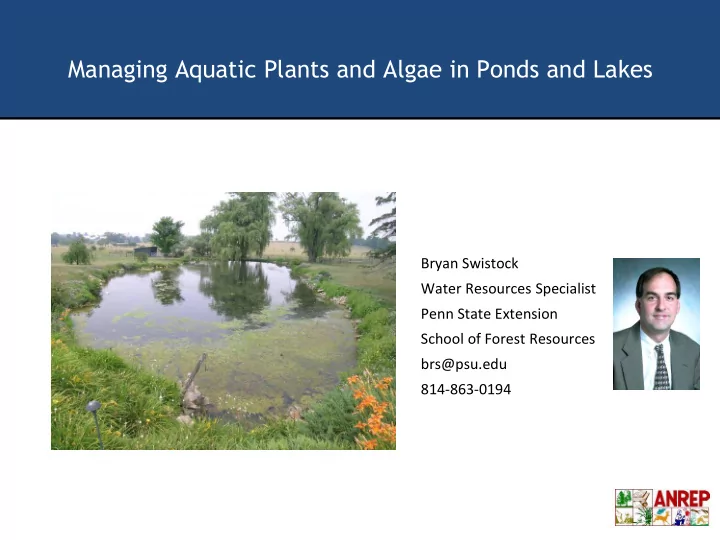

Managing Aquatic Plants and Algae in Ponds and Lakes Bryan Swistock Water Resources Specialist Penn State Extension School of Forest Resources brs@psu.edu 814-863-0194
Plant/Algae Problems are Common 60 52 40 34 percent 26 20 9 8 0 Plants/Algae Nuisance Leaks Water Quality Fish Kills Wildlife
Desirable Aquatic Plant Communities • Native species • Diverse mixture • Moderate density (20-30%)
Why do Aquatic Plants Grow? Water + Sunlight + Nutrients + (Transport?) Balanced ecosystem = 20 to 30% plant coverage Problems occur with: -Nitrogen and phosphorous inputs -Sedimentation (decreased depth) -Increased transport
Factors Causing Plant/Algae Growth • The pond or lake “watershed” • Land uses, nutrients, sediment • Source of pond/lake water • Groundwater better than surface water • More consistent flow, fewer nutrients and sediment • Pond or lake depth • Shallow water promotes more growth
Proper Identification is the First Step to Control ! Algae Submerged Plants Emergent Plants Floating Plants
Common Type of Pond Algae Filamentous algae Planktonic algae
Harmful Algae Blooms (HAB) ● Some blue-green algae can produce dangerous toxins ● Avoid human and animal contact if water has these symptoms: o Floating layer looks like paint o Surface scums, mats or films o Discolored water or colored streaks o Floating material below the water surface HABs Anna McCartney
Common Submerged Plants Naiad Potamogetons Bladderwort Elodea Coontail Photos courtesy of Amy Smagula, New Hampshire Department of Environmental Services
Common Floating Plants Watermeal Watershield Duckweed Water Lily
Common Emergent Plant Bulrush Arrowhead Cattail Water Plantain
Exotic Invasives – Watch Out for These ! Purple Loosestrife Parrot Feather Yellow Floating Heart Photos courtesy of Amy Smagula, New Hampshire Department of Environmental Services
What are the Problem Plants ? 2% 11% 35% Algae 52% Based on Annual Chemical Control Requests
Control Starts with Measurements ● Surface area (acres) o GPS units work nicely for this ● Volume (acre-feet) ● PSU Survey – 75% of pond owners have never measured their pond – most only estimate size ● Water quality o pH, alkalinity, total dissolved solids, nitrate, temperature, dissolved oxygen, phosphate o 80% of PA pond owners have never tested pond water quality
Pond and Lake Testing ● Simple test strips available at pet and pool stores OR ● Certified testing through accredited labs ● Penn State Lab Results (2007-2014) % of Ponds with Problem 40 30 20 10 0
Nutrient Reduction Buffers Sediment ponds Septic maintenance Reduce fertilizer Stabilize Aeration banks Control animals
Physical Control Methods Raking, Pulling Dredging Harvesting Drawdown BE CAREFUL – harvesting can make some problems worse (naiad, elodea, etc.)! Dredging photo courtesy of Ed Molesky, Aqua Link, Inc. & Hydro Logic Products
Other Biological Options • Grass Carp • Control some rooted aquatic plants • Permits and use vary by state • Bacteria / enzyme products • Marketed as water quality enhancers • Out compete algae & plants for nutrients • Water chemistry important, re-treatment necessary • Aeration • Reduces nutrients in water column • Barley straw • Preventative for algae • Must be applied in fall or early spring • Mixed results
Aquatic Herbicides ● Widely used and abused ● Consider all alternatives first! ● Many pond owners quickly turn to aquatic herbicides because: o Products are available for any plant o Most work quickly o Easy to apply o Cheap (in some cases) o They work !
Herbicide Considerations ● Cost – varies from <$100 to >$1,000 per acre ● Time of year ● Toxicity to pond ecosystem (i.e. copper versus dyes) ● Permit – may not be granted for certain herbicides in certain cases ● Selective or broad spectrum – target plants ● Water use restrictions – what do you use the water for?
Herbicide Problems • Failure to acquire permit(s) • Overdose of herbicide ( Poor measurement, application, timing) • Failure to follow label ! Ignoring water use restrictions • Treating too much vegetation at one time Common cause of fish kills • Some algae developing resistance • Accumulation in sediment • Band-aid approach (perpetual treatment) • May trade one problem for another i.e. remove duckweed and get curly leaf pondweed
Survey of PA Pond Owners: Aquatic Plant Management Reality ● 46% felt a healthy pond should have essentially no aquatic plants or algae ● 39% thought some non-native aquatic plants were good for a pond ● 30% felt a buffer strip around a pond provided no benefits
Survey of PA Pond Owners: Aquatic Plant Management Reality ● 40% regularly attempt to control aquatic plants or algae Of those who control plants, what ● 49% felt pulling, raking or cutting aquatic methods do they use? plants and algae was always a good idea 100 ● 47% felt copper sulfate was not toxic at all to 80 pond fish 60 ● 23% thought aquatic herbicides should only 40 be used late in the summer when plant growth 20 was most abundant 0 ● 65% were unaware of the state permit for aquatic herbicide use ● Fewer than 20% of those who had used a herbicide had obtained a permit
Penn State Extension Pond Website http://extension.psu.edu/water/ponds
Recommend
More recommend